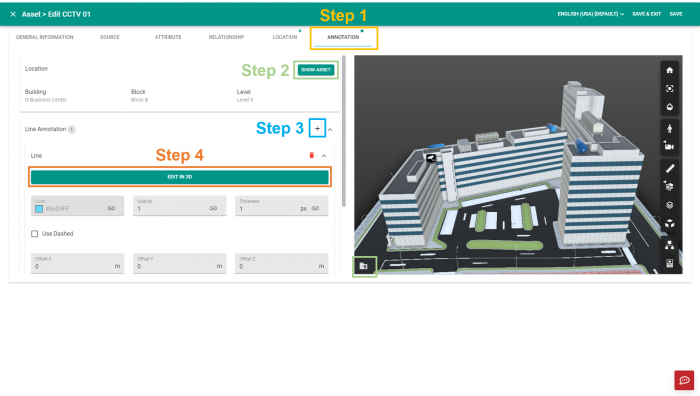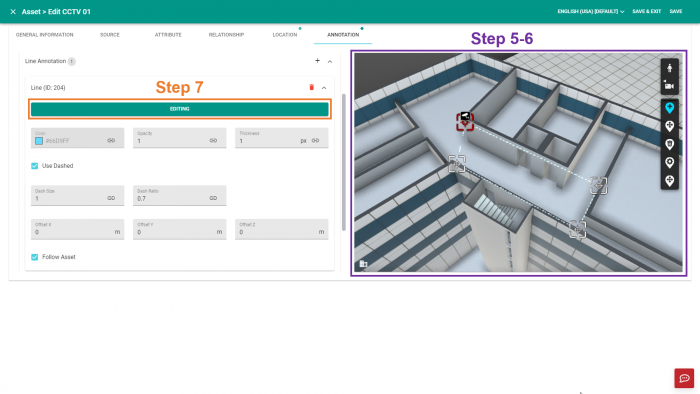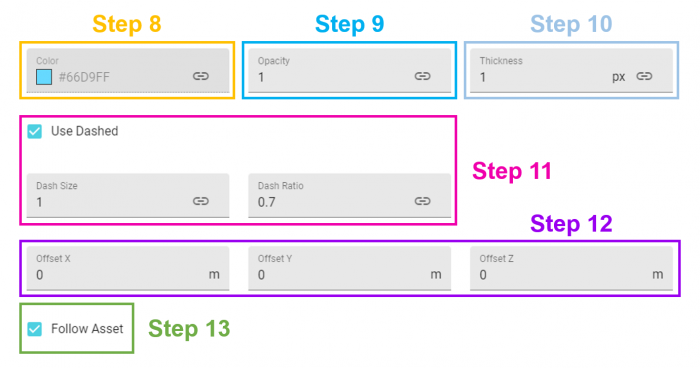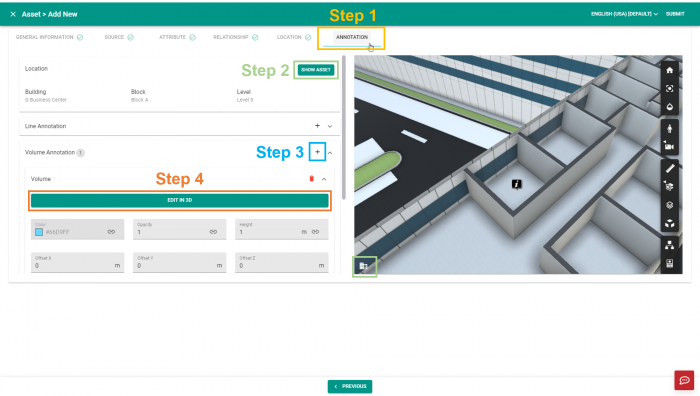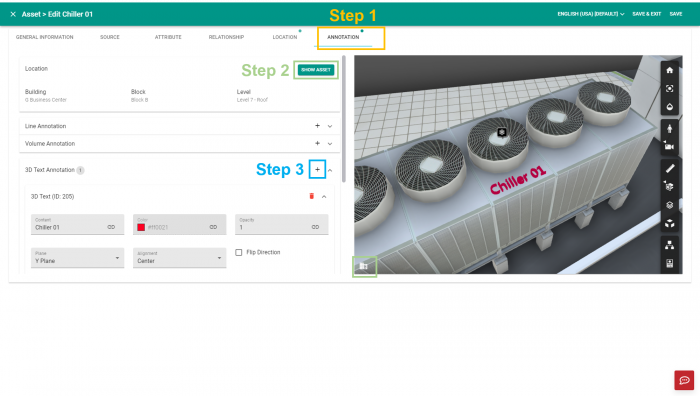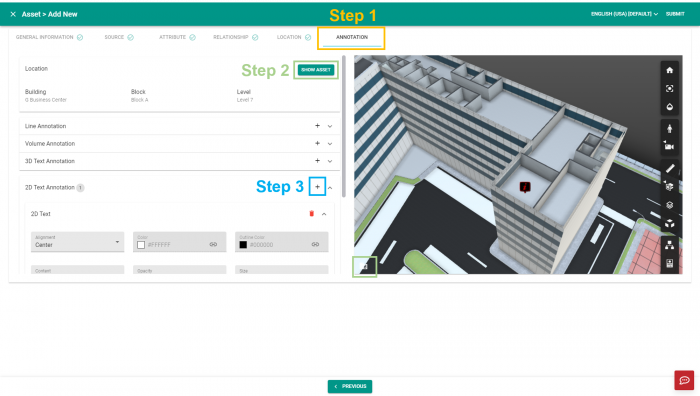Difference between revisions of "V2/CMS Tutorial/User Tools/Creating Content/Asset/Asset/Annotation"
From Senfi Docs
| Line 36: | Line 36: | ||
## When Dash ratio is set to 1.0, the gap covers the whole line. | ## When Dash ratio is set to 1.0, the gap covers the whole line. | ||
# Select "Follow Asset" if you require the line annotation to follow the asset as it moves. | # Select "Follow Asset" if you require the line annotation to follow the asset as it moves. | ||
| − | # For properties with the button, you will be able to add dynamic content to the selected property. View [[V2/CMS_Tutorial/User_Tools/Creating_Content/Asset/Asset/Annotation#Adding Annotations with Dynamic Content|"Adding Annotations with Dynamic Content"]] for more information on how to add dynamic content. | + | # For properties with the [[File:Button_Dynamic_Content.png|30px|link=]] button, you will be able to add dynamic content to the selected property instead of static content. View [[V2/CMS_Tutorial/User_Tools/Creating_Content/Asset/Asset/Annotation#Adding Annotations with Dynamic Content|"Adding Annotations with Dynamic Content"]] for more information on how to add dynamic content. |
===Steps to Adding Volume Annotation=== | ===Steps to Adding Volume Annotation=== | ||
Revision as of 18:25, 18 January 2022
Contents
Add Asset Annotation
An annotation is used to add visual information to an asset. Senfi supports 4 types of annotation, namely:
- Line
- Volume
- 3D Text
- 2D Text
An asset can have more than one annotation.
Steps to Adding Line Annotation
- Go to "Annotation" tab
- Click on "Show Asset" if you wish to place the line annotation at where the asset is located. This will help hide the 3D model above the asset's location. Else you can select
 to choose Building, Block and Level where the line annotation is to be placed on.
to choose Building, Block and Level where the line annotation is to be placed on. - Click
 on the right of "Line Annotation"
on the right of "Line Annotation" - Click "Edit in 3D" to start creating line
- Click on 3D view to create a vertex.
- Click
 to go into first person view.
to go into first person view. - Click
 to change camera interactions.
to change camera interactions.
- Click
 to fit to view.
to fit to view. - Click
 to change camera's focal length.
to change camera's focal length. - Click
 to change camera roll.
to change camera roll.
- Click
- Click
 to add a point.
to add a point. - Click
 to select and/or move a point.
to select and/or move a point. - Click
 to delete a point.
to delete a point. - Click
 to change line edit settings.
to change line edit settings. - Click
 to configure translate settings.
to configure translate settings.
- Click
- You need to create at least 2 vertices before the line appears.
- Click "Editing" to finish creating line
- Select a Color
- Set "Opacity" (value from 0 to 1)
- Set "Thickness"
- Check "Use Dashed" if you want a dashed line. If Dashed line is chosen, you can set the "Dash size" and "Dash ratio".
- Set "Offset X", "Offset Y" and/or "Offset Z" if offset of line annotation from original plotted position is required.
- The larger the Dash size, the longer the pattern.
- When Dash ratio is set to 0.05, the gap covers very little of the line.
- When Dash ratio is set to 1.0, the gap covers the whole line.
- Select "Follow Asset" if you require the line annotation to follow the asset as it moves.
- For properties with the
 button, you will be able to add dynamic content to the selected property instead of static content. View "Adding Annotations with Dynamic Content" for more information on how to add dynamic content.
button, you will be able to add dynamic content to the selected property instead of static content. View "Adding Annotations with Dynamic Content" for more information on how to add dynamic content.
Steps to Adding Volume Annotation
- Go to "Annotation" tab
- Click on "Show Asset" if you wish to place the volume annotation at where the asset is located. This will help hide the 3D model above the asset's location. Else you can select
 to choose Building, Block and Level where the volume annotation is to be placed on.
to choose Building, Block and Level where the volume annotation is to be placed on. - Click
 on the right of "Volume Annotation"
on the right of "Volume Annotation" - Click "Edit in 3D" to start creating volume
- Click on 3D view on the right to create a vertex.
- Click
 to go into first person view.
to go into first person view. - Click
 to change camera interactions.
to change camera interactions.
- Click
 to fit to view.
to fit to view. - Click
 to change camera's focal length.
to change camera's focal length. - Click
 to change camera roll.
to change camera roll.
- Click
- Click
 to add a point.
to add a point. - Click
 to select and/or move a point.
to select and/or move a point. - Click
 to delete a point.
to delete a point. - Click
 to change line edit settings.
to change line edit settings. - Click
 to configure translate settings.
to configure translate settings.
- Click
- You need to create at least 3 vertices before the volume appears.
- Click "Editing" to finish creating volume
- Select a Color
- Set "Opacity" (value from 0 to 1)
- Set "Height"
- Set "Offset X", "Offset Y" and/or "Offset Z" if offset of volume annotation from original plotted position is required.
- Change "Rotation" to adjust volume orientation.
- Select "Follow Asset" if you require the volume annotation to follow the asset as it moves.
Steps to Adding 3D Text Annotation
- Go to "Annotation" tab
- Click on "Show Asset" if you wish to place the 3D text annotation at where the asset is located. This will help hide the 3D model above the asset's location. Else you can select
 to choose Building, Block and Level where the 3D text annotation is to be placed on.
to choose Building, Block and Level where the 3D text annotation is to be placed on. - Click
 on the right of "3D Text Annotation"
on the right of "3D Text Annotation"
- Type text in "Content"
- Select a color
- Set "Opacity" (value from 0 to 1)
- Select the "Plane" you want the text to be in.
- Set "Alignment"
- You can flip the direction of the text by checking "Flip Direction"
- Adjust "Size" till desired
- Adjust "Thickness" till desired
- Set "Offset X", "Offset Y" and/or "Offset Z" if offset of 3D text annotation from original position is required.
- Change "Rotation" to adjust 3D text orientation
- Select "Follow Asset" if you require the 3D text annotation to follow the asset as it moves.
Steps to Adding 2D Text Annotation
- Go to "Annotation" tab
- Click on "Show Asset" if you wish to place the 2D text annotation at where the asset is located. This will help hide the 3D model above the asset's location. Else you can select
 to choose Building, Block and Level where the 2D text annotation is to be placed on.
to choose Building, Block and Level where the 2D text annotation is to be placed on. - Click
 on the right of "2D Text Annotation"
on the right of "2D Text Annotation"
- Set "Alignment"
- Select a color
- Select text outline color
- Type a text in "Content"
- Set "Opacity" (value from 0 to 1)
- Set "Size"
- Set "Offset X" and/or "Offset Y" if offset of 2D text annotation from original position is required.
- Change "Rotation" to adjust 2D text orientation
- Select "Follow Asset" if you require the 2D text annotation to follow the asset as it moves.

